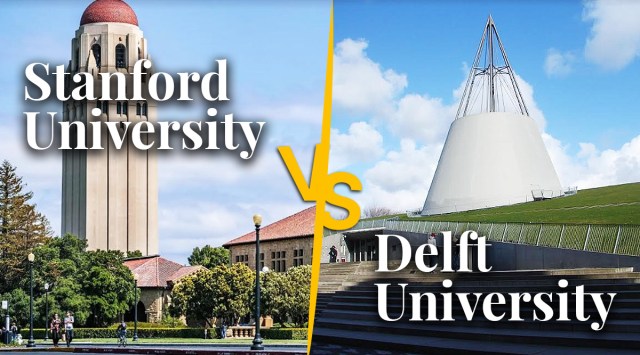Stanford University vs Delft University: Requirements for admission in Mechanical Engineering programme?
In this article, we will explore the differences between these two universities' Mechanical Engineering courses in terms of their course structure, scholarships, admission process, and extracurricular activities.
 Stanford University is ranked second, while Delft University of Technology is ranked 16th in Mechanical Engineering in the QS World University Rankings 2022. (Graphics by Abhishek Mitra)
Stanford University is ranked second, while Delft University of Technology is ranked 16th in Mechanical Engineering in the QS World University Rankings 2022. (Graphics by Abhishek Mitra) — Rahul Subramaniam
Mechanical Engineering is one of the most sought-after areas of study around the world, with its increasing employment opportunities and earning potential. Stanford University (US) and Delft University of Technology (Netherlands) are two leading universities that offer exceptional courses in this field.
Stanford University is ranked second, while Delft University of Technology is ranked 16th in Mechanical Engineering in the QS World University Rankings 2022. In this article, we will explore the differences between these two universities’ Mechanical Engineering courses in terms of their course structure, scholarships, admission process, and extracurricular activities.
Course structure
Stanford University
Stanford offers a Bachelor of Science in Mechanical Engineering (BSME) programme, which is a four-year course that focuses on developing a strong foundation in engineering principles and provides students with the opportunity to specialise in areas such as design, materials science, and biomechanics. The programme requires students to complete a core curriculum of courses in mathematics, physics, chemistry, and engineering sciences, followed by a set of electives in the chosen area of specialisation.
Delft University of Technology
Delft offers a Bachelor of Science in Mechanical Engineering programme, which is a three-year course that provides students with a broad foundation in mechanical engineering principles and offers the opportunity to specialise in areas such as sustainable energy, aerospace engineering, and robotics. The programme requires students to complete a core curriculum of courses in mathematics, physics, and engineering sciences, followed by a set of electives in the chosen area of specialisation.
Scholarships
Stanford University
At Stanford, the School of Engineering offers a range of scholarships and fellowships to both undergraduate and graduate students, including the Robert and Ruth Halperin Engineering Scholarship and the Mechanical Engineering Undergraduate Scholarship. Graduate students can also apply for the Stanford Graduate Fellowship and the Stanford Engineering Fellowship.
Delft University of Technology
Delft offers scholarships to international students through the Holland Scholarship and the Erasmus Scholarship. The Holland Scholarship is a merit-based scholarship that is awarded to students from outside the European Economic Area (EEA) who wish to pursue a Bachelor’s or Master’s degree at Dutch universities. The Erasmus Scholarship is a programme that provides funding for students to study abroad at partner universities in Europe.
Admission process
Stanford University
At Stanford, undergraduate students must apply through the common application and submit their transcripts, test scores, essays, and letters of recommendation. Graduate students must apply through the Graduate Admissions Office and submit their transcripts, test scores, letters of recommendation, and a statement of purpose.
Stanford’s undergraduate Class of 2027 acceptance rate dropped to a historic low of 3.68 per cent, according to the University’s 2022-2023 Common Data Set.
Delft University of Technology
Delft requires undergraduate students to apply through the Studielink portal and submit their transcripts, test scores, and a letter of motivation. Graduate students must apply through the university’s online application system and submit their transcripts, test scores, letters of recommendation, and a statement of purpose.
Delft University of Technology admissions are moderately competitive, admitting 65 per cent of the applicants annually.
Extracurricular activities
Stanford University
At Stanford, students can participate in over 600 student organisations, including the Society of Women Engineers and the American Society of Mechanical Engineers. The university also has a number of student-run design teams, such as the Stanford Solar Car Project and the Formula SAE team, which allow students to gain practical engineering experience.
Delft University of Technology
At Delft, students can participate in over 130 student organisations, including the TU Delft Formula Student team and the TU Delft Human Power Team. The university also has a range of design and engineering projects, such as the Delft Hyperloop project, which aim to provide students with hands-on experience in engineering.
Ultimately, the choice between Stanford University and Delft University of Technology will depend on the individual student’s preferences, career goals, and financial situation. Nevertheless, it remains crucial for students to focus on putting their best foot forward in their application, while highlighting their strengths, unique qualities, and fit at the university of their choice.
(The writer is the Co-Founder and MD at Athena Education)
- 01
- 02
- 03
- 04
- 05































